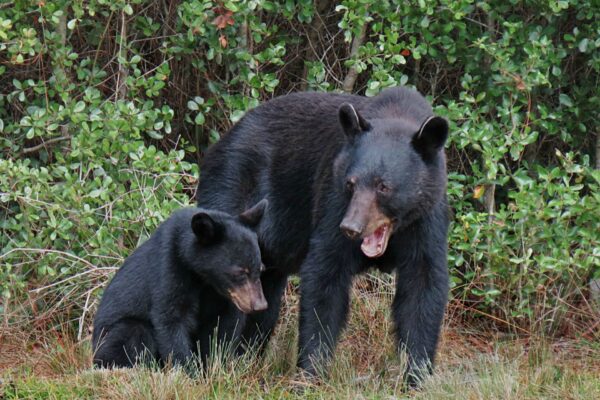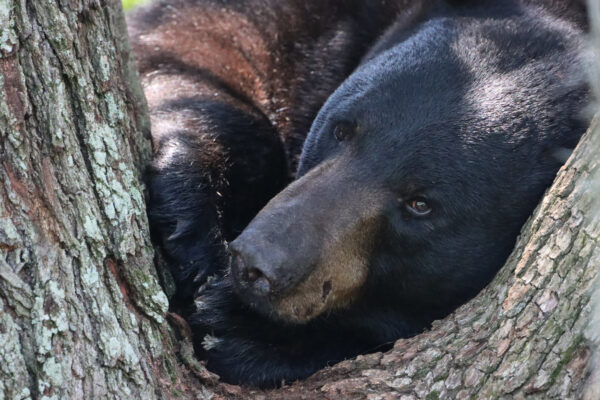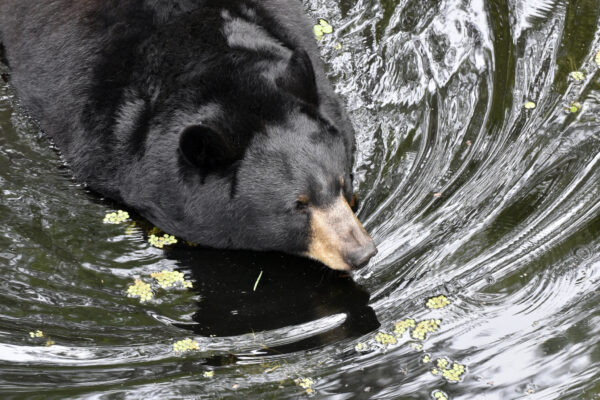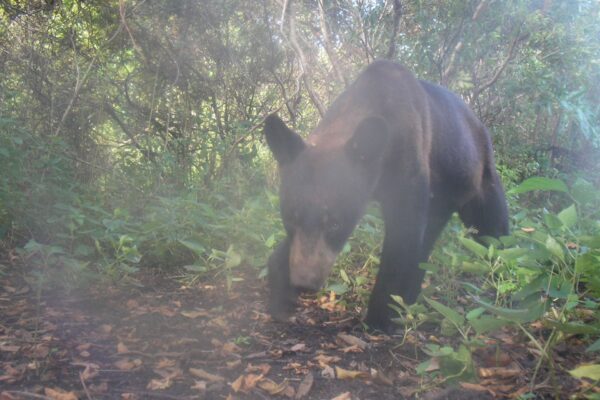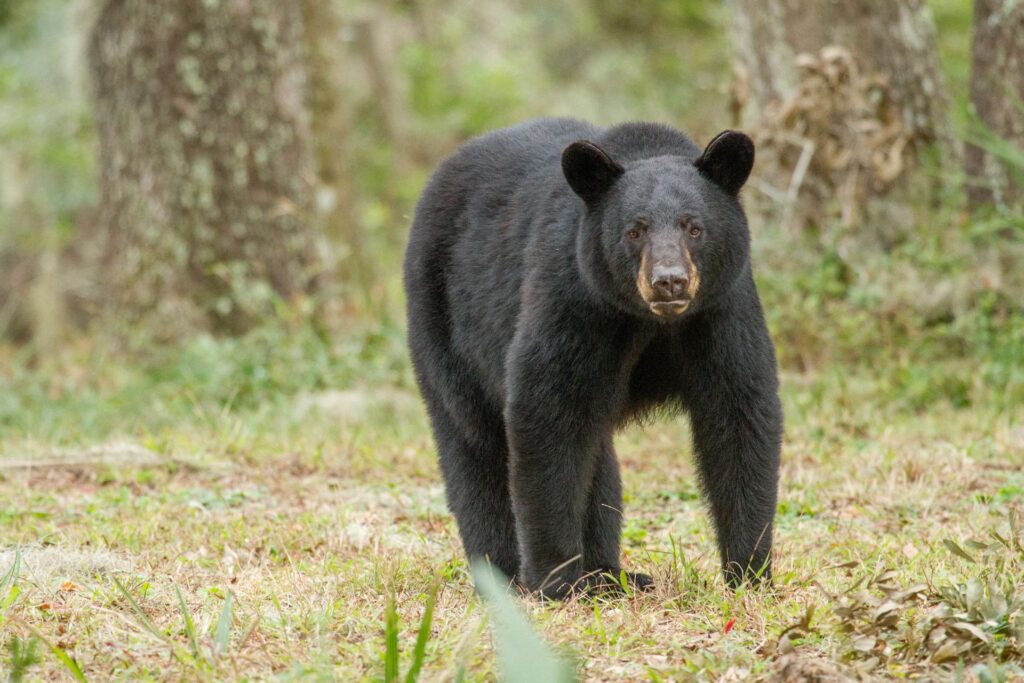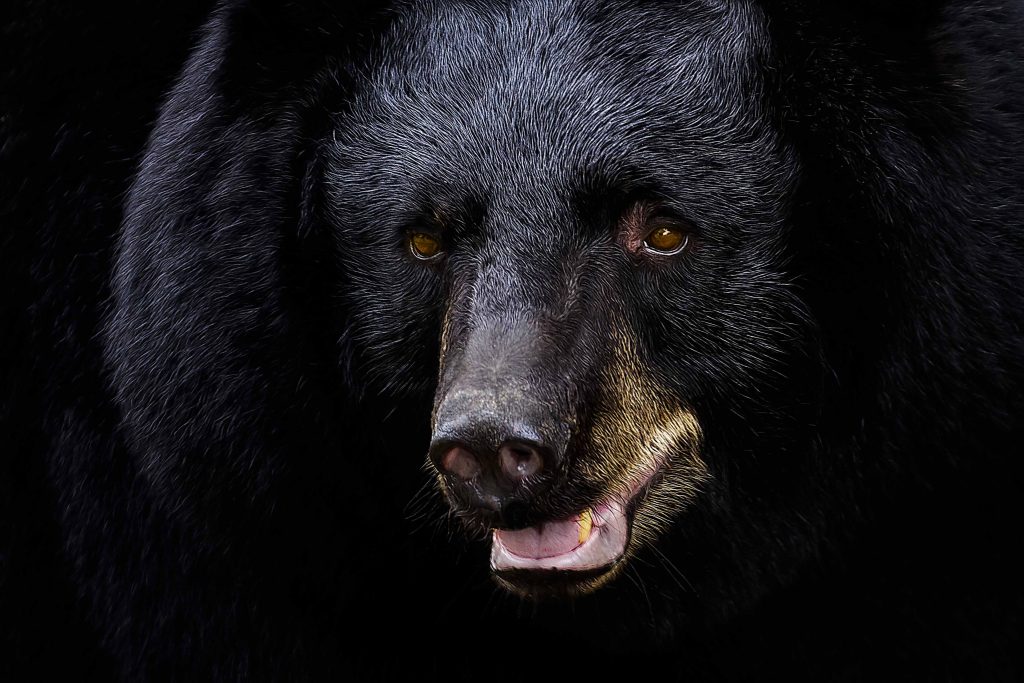Florida’s remaining black bears require vast, protected habitats to thrive. As the state’s human population surpasses 23 million, the need for preserving natural spaces has never been more urgent. The Florida Wildlife Federation is committed to safeguarding these critical habitats to ensure a future for the Florida black bear and all the unique wildlife that make our state truly special.
The Florida Black Bear
Protecting the Florida Black Bear
The Florida black bear (Ursus americanus floridanus) is the only bear species in Florida. Found throughout many habitats, including swamps and flatwoods, their growing population is increasingly encountering human habitats due to urban development.
- Habitat: Swamps, flatwoods, oak scrub, hammock
- Population: Estimated at 4,000 individuals
- Conservation Status: Officially classified as “Recovered” in 2012
Today’s Challenges
Florida’s black bears face mounting challenges that threaten their survival and well-being. Once abundant across the state, black bear populations declined significantly in the late 60’s resulting in the state listing the species “threatened.” Conservation efforts over the last several decades have helped the black bear populations recover, however habitat loss and fragmentation caused by rapid urbanization remains a challenge. As their habitats shrink, bears are pushed into smaller, disconnected areas, making it harder to find food, mates, and safe spaces to roam while also increasing their risk of vehicle collisions—one of the leading causes of bear mortality. When bears venture into human-dominated areas in search of food, this can lead to dependency on humans, reducing their natural wariness and raising safety concerns. Without strong conservation efforts, these threats will continue to endanger the long-term survival of Florida’s black bears.
Conservation in Action
Bear Management Updates (May 21, 2025) –
On Wednesday May 21, the Florida Fish and Wildlife Conservation Commission (FWC) voted to move forward with draft rules that could reinstate a regulated black bear hunt in Florida. In a 4–1 vote, Commissioners approved a framework allowing a bear hunt. We are currently evaluating the preliminary approval of alternative 2 with additional elements.
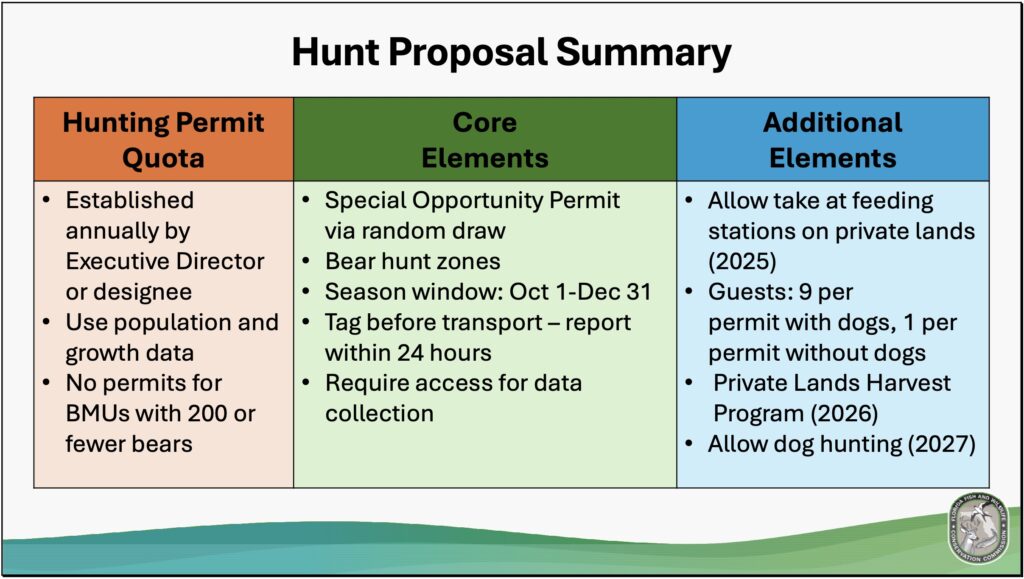
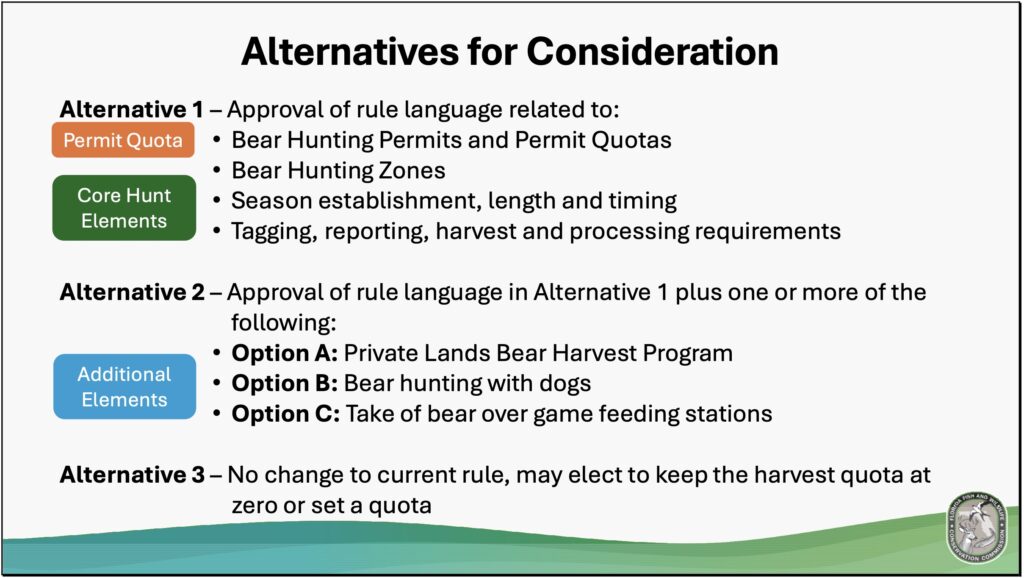
This decision comes despite the Florida Wildlife Federation’s request to delay the decision until the completion of pending assessments. In February, we formally asked FWC to address key questions before considering a hunt, and earlier this month we submitted recommendations to the Commissioners to base bear management on science, prioritize non-lethal methods, and justify and adapt hunts with clear data and objectives.
These rules are not yet final. FWC will continue refining the proposal and collecting public input ahead of another vote, currently scheduled for August 13-14 in Tallahassee.
We’ll keep you updated with opportunities to take action and speak up before the final vote.
The Florida black bear was classified as a “Recovered” species in 2012 after decades of conservation efforts, with a population now exceeding 4,000. Despite this success, the species remains protected under state law and requires ongoing monitoring. Data-driven management policies are crucial to address conservation challenges and ensure long-term stability. As an “umbrella species,” protecting black bears also benefits other species sharing their habitats. Since recovery efforts began, FWF has been at the forefront of advocating for the conservation of the Florida black bear.
Today, we are working with these goals in mind:
- Land Conservation – As Florida’s human population continues to grow, the pressure on natural lands increases. Florida’s black bears need thousands of acres of protected land to roam freely and maintain genetic diversity. FWF is committed to ensuring that Florida’s bear population continues to thrive by advocating for stronger growth management policies and land conservation to protect and connect their habitats.
- Healthy Populations – Maintaining a healthy and sustainable black bear population requires scientific research to guide habitat protection, minimize human-bear conflicts, and ensure genetic diversity. This includes monitoring population trends, implementing habitat corridors to reduce fragmentation, and ensuring habitat quality can support bear populations statewide.
- Minimize Human-Bear Conflicts – Responsible human practices and improving habitat connectivity can protect the sustainability of Florida black bears. This includes securing food attractants like trash to discourage bears from entering residential areas, as well as implementing wildlife crossings and habitat corridors to reduce vehicle collisions and allow safe movement between habitats.
Learn About the Florida Black Bear
Bear cubs are born blind and covered with fine hair. At birth, they are the size of a stick of butter or a soda can, weighing 8–15 ounces. Litter sizes are anywhere from one to five cubs, with the average being two to three.
Bears have large bodies with a shiny black coat (although some may appear redder in color during certain times of the year) with a brownish muzzle. Some bears may have white patches or markings, called blazes, on their chests. Their ears are short and rounded on adults, but look more like “Mickey Mouse ears” on younger bears. The black bear has five toes with short, curved non-retractable claws that give them excellent tree-climbing ability. A bear’s superpower is their nose. They have an excellent sense of smell, being able to detect an odor from at least a mile away. Their eyesight is similar to those of humans, and they can see in color. Male black bears on average weigh between 250–450 lbs., and females typically weigh between 125–250 lbs.
This resilient bear species has shown incredible progress in conservation efforts. In the 1970s, the population of Florida black bears was reduced to only 300-500 throughout the state due to unregulated hunting and habitat loss. In 1974, they were designated as Threatened by the state of Florida and were placed on the state’s Endangered and Threatened Species List. In 2012, the Florida black bear was officially classified as a “Recovered” species after decades of concerted efforts aimed at habitat restoration, reducing human-wildlife conflicts, and raising public awareness. As a result, the population of Florida black bears has grown to an estimated 4,000 individuals in the wild. Despite this success, the species remains protected under state law, and ongoing monitoring is essential to ensure its long-term survival.
FWF involvement:
- In 2015, a bear hunt in Florida sparked widespread public outcry and raised concerns about the effectiveness of management practices. FWF helped gather expert inputand submitted key findings and recommendations to FWC, should a future hunt be considered. The priority concern was the lack of current population data to indicate the maximum sustainable harvest rate.
- In 2024, the passing of Florida House Bill 87, also known as the “Taking of Bears” bill, allowed for lethal removal of bears if they are perceived as a threat to pets, property, or human safety, regardless of the underlying causes of these conflicts. FWF strongly opposed this bill, warning that it undermines science-based wildlife management and opens the door to indiscriminate killings of bears without addressing the root causes of these conflicts.
FWF remains committed to advocating for science-based solutions that protect both people and wildlife.
The primary threats to the Florida black bear today are habitat loss and fragmentation, which have significantly reduced the amount of available land for them to roam. As human development continues to encroach on bear habitats, it forces bears into smaller, isolated areas, increasing the likelihood of conflicts with humans. This loss of land is a major factor driving bears into human-dominated areas where they are more likely to encounter dangers such as vehicle strikes when crossing roadways.
While Florida black bears tend to avoid humans, their extreme food drive is attracted by things that we leave around our homes. Because of their amazing sense of smell, bears can get into trouble by accessing outdoor garbage cans, bird feeders, pet food, and other easy calories in human-dominated areas. They can become dependent on a food source and begin to become too comfortable around people, so it is crucial to secure trash cans, remove attractants, harvest ripe produce, and compost responsibly, while always maintaining a safe distance from bears.
Black bears are solitary animals; however, they can be found together when in a mother-cub family unit or as pairs during mating season. They will tolerate each other and forage in groups if there is an abundance of food in one area. Black bears can run up to 35 miles per hour and can climb 100 feet up a tree in 30 seconds. They are also excellent swimmers. Bears are naturally wary and people and are typically active at dawn and dusk.
Florida black bears need large areas of land to travel and survive. An adult female has an average home range of up to 15 square miles while an adult male averages 60 square miles. Females have a smaller range because they are more cautious when moving with cubs. Bears communicate through vocalizations and body language.
If you encounter a bear, it may stand up on its hind legs. This is not an aggressive behavior; instead, the bear is trying to assess whether you are a threat by using their nose to air scent and eyesight to get a better view. Bears let us know through vocalizations and body language when they are uncomfortable. They may huff out air and clack their teeth, do jaw popping, or even bluff charge. These are all ways a bear lets us know that we are too close. Behaviorally, if a bear’s behavior changes because you are there, that is a sign that you are too close and you should slowly back away while speaking calmly.
To learn about black bear vocalizations and body language, here is a link to the North American Bear Center’s webpage on various bear vocalizations and body language.
Florida black bears can be found primarily in forested and rural areas across the state, with their range covering most of peninsular Florida and parts of the panhandle. They are typically found in habitats such as swamps, wetlands, hardwood forests, and mixed woodlands, particularly in areas with dense vegetation and abundant food sources.
Black bears prefer habitats with dense understories such as forested wetlands and uplands but will use a variety of habitats depending on the season. Habitats need to provide food, water, shelter and corridors to travel. Their ideal habitat would have plenty of trees and plants to provide a seasonal variety of nuts and fruits.
Females that are pregnant may den in areas dense with palmettos. They may also choose to den in day beds (which are similar to nests) in thick areas, under downed trees, or even in tree cavities. In these areas, she is able to better protect her cubs by removing them should she hear twigs or brush break nearby.
Human population growth has significantly contributed to habitat fragmentation, limiting the available space for bears. Historically, Florida black bears were found throughout much of the state including some coastal areas, but their range has now shrunk to only about 49% of their historic territory. The bear population is now fragmented into six large populations and two smaller ones.
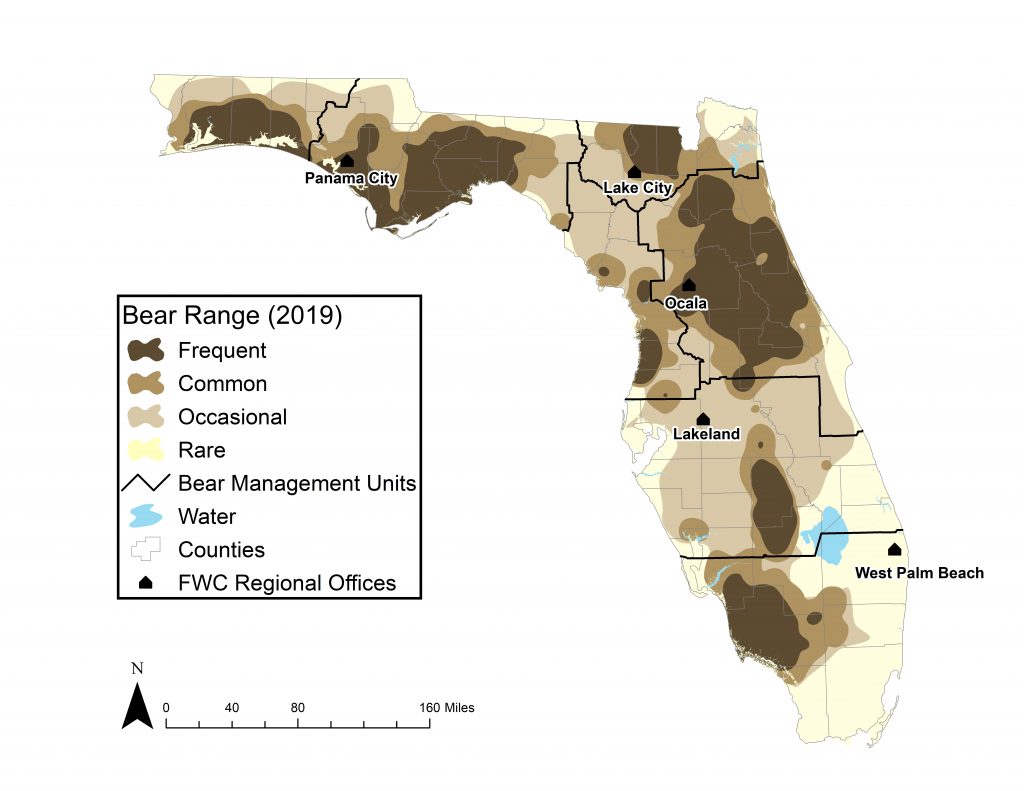
Florida Black Bear (Ursus americanus floridanus)
Kingdom: Animalia – Includes all animals, excluding plants and single-celled organisms.
Phylum: Chordata – Characterized by having a spinal cord.
Sub-phylum: Vertebrata – Animals with a backbone.
Class: Mammalia – Warm-blooded animals that nurse their young.
Order: Carnivora – Classified based on body structure, though not all are strict carnivores.
Family: Ursidae – The scientific family name for bears.
Subfamily: Ursinae – A subgroup within the bear family.
Genus: Ursus – Latin for “bear.”
Species: americanus – Refers to its North American origin.
Subspecies: floridanus – Denotes that this particular black bear is found in Florida.
Bears are opportunistic omnivores (eat both plants and animals) since their diet is largely determined by whatever they find. However, approximately 80% of their diet comes from plants (acorns, saw palmetto, nuts, berries, and other vegetation). Another 15% of their diet comes from colonial insects (termites, ants, wasps, and bees, as examples). The remaining 5% of their diet is meat, typically things that are dead or play dead (armadillo, opossum). Their diet fluctuates seasonally based on plant productivity so if there is a failure of one food source, there are other sources available for them. The various oaks that are native to Florida all produce a different kind of acorn, which are one of a bear’s favorite seasonal foods. Another favorite is the saw palmetto, as bears will eat the heart and the seasonal berries.
Their weight also fluctuates throughout the year. Bears generally eat 5,000 calories a day, except in the fall months, when they eat close to 20,000 calories a day. This time of heavy eating is called “hyperphagia”, where they put on as much weight as possible to prepare for winter. Food availability tends to be lower during the Florida “winter months” so they go into hibernation, even in Florida. However, this hibernation is called “winter lethargy”, and they do not fall into a deep sleep. Instead, they may move more slowly and nap for longer periods of time. With at least some food available year-round, individuals may only slow down for a few weeks.
As of 2018, there have been 15 people injured by Florida black bears.
Mating season runs from June to early August, and cubs are born generally the last week of January/first week of February. Adult females reach maturity between three and four years old and typically have litters every other year. Bears have a reproductive mechanism called delayed implantation, so after breeding, the female must put on enough fat and weight during the fall months to support herself and cubs; otherwise, she will not have cubs that year.
Females pregnant with cubs will not begin to roam the area again until the cubs are old enough and big enough (6-8 lbs.) to move about with her. Bear cubs stay with their mothers until 15 – 17 months of age, at which point they go through “family break-up”. Mom will chase them away so they start lives on their own and she will go back into the breeding cycle. Lifespan expectancy depends on the age of the bear; however, under human care, they have been known to live into their 30s. The oldest male bear known about in Florida was 20 years old, and the oldest female was 22 years old. It is difficult to give average life spans because most bears are not documented and followed by biologists.
Florida black bears play a vital role in maintaining the health of their ecosystem. As they forage for food, they consume a variety of fruits and berries, later dispersing the seeds through their scat, which helps regenerate plant populations and promote forest diversity. Their movement across different habitats ensures that seeds are spread over large areas, supporting plant growth in places where it might not otherwise occur. This natural process contributes to the balance of plant communities, benefiting other wildlife that depends on these habitats for survival.
In addition to seed dispersal, Florida black bears impact soil health through their foraging behavior. When they dig for insects or tear apart rotting logs in search of food, they aerate the soil, helping to decompose organic matter and recycle nutrients back into the ecosystem. This activity creates opportunities for new plant growth and provides shelter for smaller organisms. While these bears are mostly solitary, they may gather in areas with abundant food, such as fruiting trees or rich foraging grounds, momentarily interacting before resuming their independent lifestyles.
How to Help
Florida’s black bears are an essential part of the state’s ecosystem. These animals help maintain the balance of their habitats, dispersing seeds and controlling insect populations.
Without urgent action to protect and restore their habitats, educate the public about coexistence, and enforce sound wildlife management policies, the future of this iconic species remains uncertain.
You can help by:
- Donating to FWF to help safeguard Florida black bear habitats through land conservation.
- Educating your community on how to live responsibly alongside bears.
- Advocating for wildlife-friendly infrastructure to ensure safe bear movement and reduce road fatalities.
Latest news about the Florida black bear
Florida Black Bear F.A.Q.s
How many Florida black bears are there in the state?
The latest research done by the Florida Fish and Wildlife Conservation Commission (FWC) in 2017 showed an estimate of 4,050 bears throughout the state.
What should I do if I encounter a Florida black bear?
Should you encounter a bear at close range, the FWC suggests that you remain standing, back away slowly, and speak to the bear in a calm, assertive manner. Do not turn your back, or play dead. Do not run, as this can trigger the chase instinct in some animals, including bears. Do not make any sudden or abrupt movements. Avoid direct eye contact, as some may view this as a threat.
If a bear stands on its hind legs, this is not aggressive behavior. It is trying to see you better to assess whether you are a threat or not.
If a bear comes towards you, paws the ground, huffs or clacks their jaws, they are showing that they are uncomfortable and are trying to get you to give them space. Continue talking and backing away slowly with your arms raised to make yourself look bigger. In the unlikely event that a bear charges and makes contact with you, fight back!
If you are in your yard, make sure you are in a safe area and the bear has an escape route. Make noise or bang pots and pans to scare the bear away.
Remember that bears are wild animals and while they are generally shy want to avoid humans, they have the ability to seriously harm humans. Give them plenty of space; if their behavior changes because you are there, then you are too close.
How can I keep my property wildlife-friendly for bears?
The best way to prevent bear encounters near homes is to secure all attractants. Store trash in bear-resistant containers, bring in pet food at night, clean grills after use, and remove fallen fruit from yards.
Are Florida black bears dangerous to humans?
Florida black bears are typically shy and avoid humans, but they may become more visible if food is left unsecured. While not usually aggressive, they are strong and can react defensively if provoked, especially when protecting cubs or food. Studies show they avoid confrontation 90% of the time, often giving warning signs like jaw popping or bluff charges before any attack. Bear attacks on humans are extremely rare.




